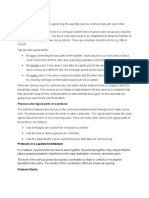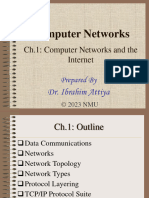0% found this document useful (0 votes)
58 views28 pagesCommunication Protocols - Computer Science
The document discusses communication and internet technologies, focusing on protocols that govern data transmission between sender and receiver. It outlines the TCP/IP protocol suite, detailing the application, transport, internet, and link layers, along with their respective protocols and functions. Additionally, it covers various protocols for email, Ethernet, WiFi, Bluetooth, and WiMax, highlighting their roles in facilitating data communication over networks.
Uploaded by
veenyagz711Copyright
© © All Rights Reserved
We take content rights seriously. If you suspect this is your content, claim it here.
Available Formats
Download as PDF, TXT or read online on Scribd
0% found this document useful (0 votes)
58 views28 pagesCommunication Protocols - Computer Science
The document discusses communication and internet technologies, focusing on protocols that govern data transmission between sender and receiver. It outlines the TCP/IP protocol suite, detailing the application, transport, internet, and link layers, along with their respective protocols and functions. Additionally, it covers various protocols for email, Ethernet, WiFi, Bluetooth, and WiMax, highlighting their roles in facilitating data communication over networks.
Uploaded by
veenyagz711Copyright
© © All Rights Reserved
We take content rights seriously. If you suspect this is your content, claim it here.
Available Formats
Download as PDF, TXT or read online on Scribd
/ 28






















































































